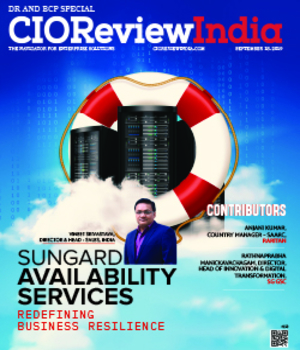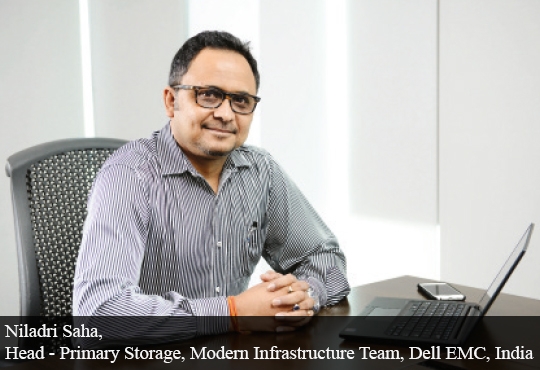The Key Trends Around Data Centre And Distributed Environments In India
Anjani Kumar, Country Manager - SAARC, Raritan
 Data is the new oil of the digital era. Internet of Things is playing a major role in the way data is being produced and used in the country. With massive amount of data being produced, enterprises benefit when it becomes a strategic asset for business. On one hand, abundance of data is changing the nature of competition while on the other hand, data is increasingly becoming a vulnerability. This calls for an integration of both cloud and physical solutions, that not only improves efficiency but secures data for enterprises and the government.
Data is the new oil of the digital era. Internet of Things is playing a major role in the way data is being produced and used in the country. With massive amount of data being produced, enterprises benefit when it becomes a strategic asset for business. On one hand, abundance of data is changing the nature of competition while on the other hand, data is increasingly becoming a vulnerability. This calls for an integration of both cloud and physical solutions, that not only improves efficiency but secures data for enterprises and the government.
India has seen rapid adoption and increased investment in data centres. According to Gartner, data centre spending in 2018 grew a whopping 15.5 percent to USD 210 billion year over year, which was by far the largest growth area in the IT industry. As per an IAMAI report, the country is poised to be the second largest market for data centres in Asia-Pacific by 2020.
This is an indication of how fast enterprises are moving from conventional roles to becoming hubs of innovation. Agility, flexibility and scalability are basics that are a given outcome of data solutions these days. With so much going on in the industry, here are top five trends that are changing the way data centres work:
“As modern data centres become an important part of a company’s customer experience strategy, automation can help businesses achieve customer needs holistically and in real time”
IoT in the Data Centre: As data continues to grow each day, IoT deployments will enable real-time processing of data. This will provide faster and accurate understanding of data which will ensure enhanced utilisation and productivity. However, processing large quantities of data in real-time increases workloads of data centres, posing new security, capacity and analytics challenges.
Impact of AI: Utilising AI for data management is not new to this industry, however, understanding how it can be leveraged for a data-driven business is a must. AI-powered predictive analytics tools easily manage data by optimizing storage and compute load balancing in real-time. Apart from being self-managed, self-improving of these AI tools help manage servers more efficiently. Gartner predicts that by 2020, more than 30 percent of data centres that fail to implement AI and Machine Learning will cease to be operationally and economically viable. This is pushing data centres to go beyond the traditional ways of data management.
Software Defined Solutions (SDS): Data explosion isn’t set to end anytime soon. With software-defined storage as part of storage infrastructure, businesses can ensure that the most important data is held on their Storage Area Network (SAN) while the less important, unstructured data reaches at the backend of storage system. SDS works smartly by enabling dynamic storage adaptation and functions to gain control and efficiency over infrastructure capabilities.
Adapting Open Source Software: New-age data centres are built on Open Source technologies that help to achieve interoperability between traditional and cloud-based models. These are an added advantage to facilitate seamless integration of today’s hybrid infrastructures. The trend is widely catching up in India as data centre managers are realising the quick deployment and flexible nature of open source software that outweigh closed-source options.
Data Centre Co-locations in Your Hybrid Environment: IT leaders are often faced with the challenge of effectively integrating multiple infrastructures into a single, optimally functioning environment, also known as Hybrid IT. Many co-located data centres can offer a solution to this challenge by providing the capabilities that make a hybrid environment look attractive, including a secure, private cloud with access to public clouds. With co-located data centres deployment and management of hybrid data centre becomes easy.
Modern enterprises need not only assess these trends but take proactive measures to optimize data centres and stay relevant to compete in the global market. The wave of digital transformation has hit the Indian data centre market enticing enterprises to upgrade their businesses. Agility and scalability of public cloud, and security of private cloud, coupled with deep technologies offer new and improved infrastructure standards for data centres to opt for. As modern data centres become an important part of a company’s customer experience strategy, automation can help businesses achieve customer needs holistically and in real time.
CIO Viewpoint
Empowering Women: Shaping the Future of Industry
By CIOTechOutlook Team
Scaling AI: Finding the right Biztech...
By Sujatha Gopal, CTO - Communications, Media & Information Services (CMI), Tata Consultancy services
Gen AI: Transforming Cloud Solutions for...
By Matt Yanchyshyn, VP - AWS Marketplace & Partner Services, AWS
CXO Insights
Impact Of Pandemic On Different Countries
By Sonica Aron, Founder & Managing Partner, Marching Sheep
Why The Data Center Is At The Heart Of The...
By Niladri Saha, Head - Primary Storage, Modern Infrastructure Team, Dell EMC, India
Alternative Ways Of Approaching Incident...







